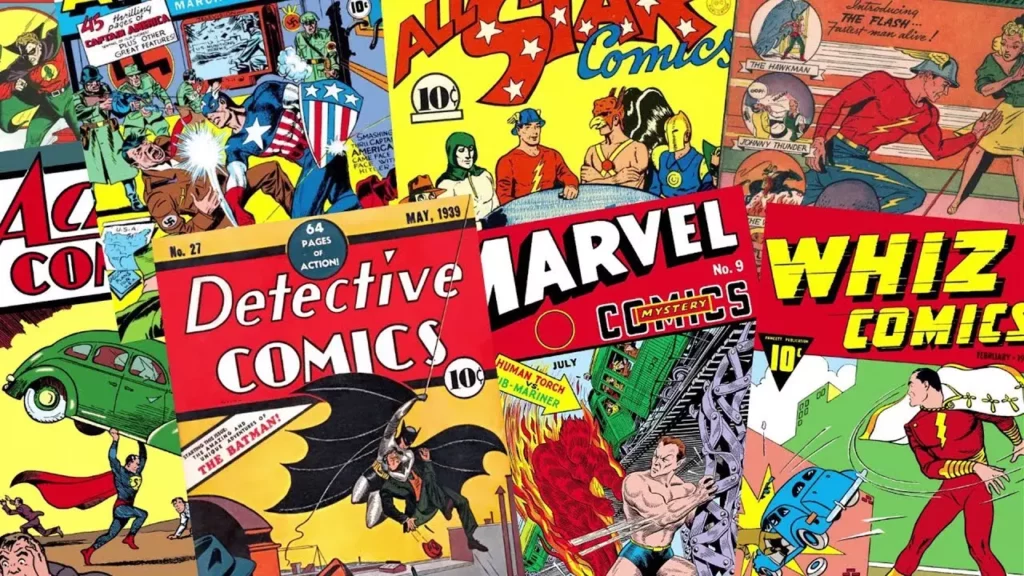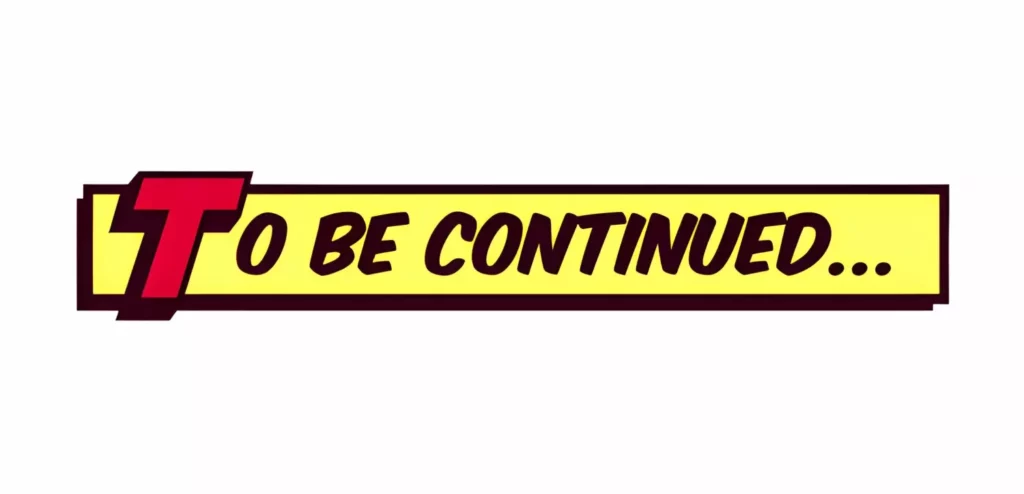If you count yourself among those who often lament, “Ah, the good old days were superior!” then this piece is tailor-made for you. In our narrative today, we’ll sequentially navigate through the various historic periods of comic books, from the illustrious Golden Age right through to the contemporary era. It’s advisable to prepare a steaming cup of tea and perhaps a couple of sandwiches, as we embark on this captivating exploration.
We shall commence with the illustrious Golden Age, an epoch characterized by the dawn of legendary superheroes and the genesis of a novel cultural marvel. This era established the foundations of what comic books could represent, amalgamating artistry with storytelling in a manner that enthralled a diverse audience. Subsequently, we’ll delve into the Silver Age, an era marked by creative proliferation and innovative exploration. During this time, the comic book medium was redefined, introducing more intricate characters and plots. Advancing forward, we’ll scrutinize the Bronze Age, renowned for its socially conscious and realistic narratives. This period mirrored the evolving societal dynamics and the maturing preferences of its readership. Culminating in the Modern Age, we’ll witness the transformation of comics into a multifaceted and refined form of literature, frequently addressing current issues and appealing to a broader spectrum beyond the conventional comic book aficionados. So, whether you’re an avid comic book connoisseur or a newcomer to the realm of graphic storytelling, embark with us on this enthralling voyage through the opulent history of comic books.
When was the Golden Age of comics
Golden Age (1938 – 1956)
The Golden Age of comics roughly spanned from 1938 to 1956. Imagine a time when newsstands overflowed with colorful pamphlets promising thrilling adventures and larger-than-life heroes. This was the Golden Age, where the seeds of comic book fandom were sown.
It all started with a bang in 1938. Superman, the Man of Steel, burst onto the scene, captivating readers with his extraordinary powers and unwavering moral compass. Soon, Batman, Captain America, Wonder Woman, and countless others followed, each with their own unique mix of abilities and struggles. Action Comics #1 featuring Superman and Detective Comics #27 with Batman’s debut became cornerstones of this era.
Golden Age comics were uncomplicated: good versus evil, clear-cut morals, and action-packed narratives. Nazis were punched, monsters vanquished, and injustices righted, all within the span of a few pages. These simple stories resonated deeply with readers facing the anxieties of the Great Depression and World War II. Heroes provided much-needed escapism and inspiration.
Art styles were bold and dynamic, often influenced by newspaper comic strips. Vibrant colors and exaggerated features helped convey action and emotion. The stories unfolded through panels, filled with word bubbles and narration boxes, capturing the imaginations of young readers.
By the mid-1950s, the Golden Age faded. Comics faced growing scrutiny for perceived violence and juvenile content. But its legacy lived on. The iconic heroes spawned countless adaptations and new generations of creators. The spirit of adventure and the power of storytelling, born in that golden era, continues to captivate audiences today.
So, the next time you see Superman soar or Batman stalk the shadows, remember the Golden Age that gave them life. It was a time of simple stories with big impact, where heroes were born on pulp paper and imagination took flight.
When was the Silver Age of comics
Silver Age (1956 – 1970)
Following the Golden Age’s superhero boom, the Silver Age comics soared from 1956 to roughly 1970. Imagine a time when science fiction buzzed, technology dazzled, and the classic heroes got a shiny reboot. The Silver Age was like a cosmic upgrade, injecting fresh energy into comic storytelling.
The spark came in 1956 with Showcase #4, introducing a new, faster Flash. This revitalized the superhero genre, leading to revamps of old favorites like Batman and Superman. They shed their darker wartime tones for brighter costumes and lighter stories, embracing camp and humor alongside adventure.
The cosmos became a playground. Green Lantern patrolled intergalactic space, the Fantastic Four rocketed through dimensions, and Silver Surfer rode cosmic waves. Sci-fi elements mixed smoothly with superhero action, pushing the boundaries of imagination.
While still upholding good versus evil, the Silver Age explored morally complex characters. Anti-heroes like Magneto and the Punisher emerged, blurring the lines between hero and villain, and adding depth and nuance to narratives.
Art styles started using dynamic movement and bolder colors. Panels exploded with kinetic energy, reflecting the faster-paced stories. Characters were drawn with more expressive faces and exaggerated features.
The Silver Age wasn’t perfect. Some argue it sacrificed the Golden Age’s grit for fluff. But its impact is undeniable. It revitalized the industry, introduced iconic characters and teams, and paved the way for even more diverse and complex stories in the Bronze Age and beyond. Next time you see Barry Allen zipping through time or the Fantastic Four battling galactic monsters, remember the Silver Age, the era that gave these classics a second wind.
When was the bronze age of comics
Bronze Age (1970 – 1985)
The Bronze Age of comics unfolded like a gritty detective story, roughly spanning 1970 to 1985. Think less shiny spaceships and more anti-heroes, as the superhero genre grappled with social topics and darker themes.
In 1970 Jack Kirby, a comic legend, left Marvel and headed to DC, bringing with him a more character-driven style. This marks the symbolic start of the comics Bronze Age, as classic heroes like Superman and Batman shed their campy veneer, facing more complex challenges and personal demons.
Vietnam, Watergate, and the Civil Rights movement cast long shadows. The Bronze Age comics mirrored these anxieties, with stories tackling social injustice, environmental concerns, and political corruption. Green Arrow became a social activist, Luke Cage fought for the rights of Harlem, and Wonder Woman explored feminist themes.
The line between hero and villain blurred. Wolverine, a gruff mutant with questionable morals, clawed his way into popularity, followed by Punisher, a vigilante fueled by brutal vengeance. These anti-heroes, wrestling with inner demons and moral ambiguity, resonated with audiences seeking more complex and closer-to-real-life characters.
Art styles adapted to the darker tone. Neal Adams’ Batman became a chiseled vigilante lurking in Gotham’s shadows, while John Romita Jr.’s Spider-Man swung through New York City. The panels reflected the emotional intensity and physical brutality of the narratives.
Big publishers weren’t the only game in town. Independent comics like Cerebus and Maus emerged, tackling mature themes and pushing the boundaries of storytelling. This creative freedom injected fresh perspectives into the comic book world.
The Bronze Age wasn’t all doom and gloom. The humor still thrived, with characters like She-Hulk breaking the fourth wall and Howard the Duck bringing absurdist adventures. But its legacy lies in its willingness to challenge conventions, explore mature themes, and introduce darker heroes that still resonate today. Next time you see Wolverine unleash his berserker rage or Daredevil beating the hell out of a crime boss, remember the Bronze Age, the era that painted the superhero universe with a darker, more realistic paint.
When does the modern age of comics start
Modern Age (1985 – Present Day)
Comic experts often debate the timeline of Modern Age comics, with estimates ranging from the mid-1980s to the early 2000s and/or our days.
Events like Crisis on Infinite Earths and Secret Wars reshape the DC and Marvel universes, paving the way for a fresh start with new continuities and bolder storytelling. This period marks a potential starting point for the Modern Age, a shift towards greater creator control and complex narratives.
The Dark Knight Returns in 1986 casts a long shadow. Gritty, deconstructivist stories become more common, challenging traditional superhero tropes and exploring the psychological toll of heroism. Think Watchmen, V for Vendetta, and Alan Moore’s swamp-thing Swamp Thing.
Independent publishers truly shined, offering platforms for diverse voices and mature themes. Neil Gaiman’s Sandman redefines fantasy, Vertigo Comics pushes boundaries with titles like Hellblazer, and Image Comics brings creator-owned heroes like Spawn and Savage Dragon to the forefront.
DC and Marvel respond by giving creators more freedom and experimenting with darker, more mature storylines. The Death of Superman, Knightfall, and Marvel’s Civil War showcase this shift, proving that mainstream comics could tackle complex themes while still entertaining a wide audience.
The 21st-century, with online platforms like ComiXology and Marvel Unlimited has revolutionized distribution and made comics way more accessible. This opens doors for new creators and genres, further diversifying the comics landscape.
So, whether you’re a fan of Alan Moore’s deconstructivist masterpieces, Jonathan Hickman’s epic crossover events, or the latest indie sensations, remember you’re experiencing the ever-evolving Modern Age of comics.
How Does A Comic’s Value Change With Its Age?
A comic’s value is a complex equation with age playing a key role, but it’s not the only factor. Imagine it like a superhero team-up where age provides the base power, but other factors amplify or weaken it. So before you decide to sell comic books from your collection – read what we have to say about it.
- Generally, older comics are more valuable. Time filters out less popular issues, leaving behind rare gems. Think Action Comics #1 featuring Superman’s debut – its age, coupled with its historical significance, makes it a priceless treasure.
- A common comic from yesterday might not be worth much, but a limited edition issue from last month could be a gold mine. Scarcity drives up demand, just like limited edition Batarangs.
- But even the oldest comic won’t be worth much if it’s crumbled and coffee-stained. Pristine condition acts like Captain America’s shield, protecting value.
- Certain characters or storylines are just more popular like Spider-Man swinging ahead of lesser-known heroes. Comics featuring these fan favorites naturally see their value boosted. Events like movie adaptations or anniversary celebrations can shine a spotlight on older comics, temporarily inflating their value.
Ultimately, a comic’s value is a dynamic web. Age provides the foundation, but rarity, condition, popularity, and even cultural trends all play a part in determining its true worth. Remember, even a seemingly ordinary comic could hold hidden value, waiting to be discovered like a forgotten issue in the Batcave! Just give it some time.
-
Pete Przysiezny, owner of Comic Buying Center, has been buying and selling comics and collectibles for over 30 years. He lives in Northern Illinois and specializes in buying large comic book collections. He has a vast knowledge of all eras and types of comic books ranging from the 1930s to the 2000s. Pete spent his childhood going to comic book conventions with his father, so you could say he was raised in the industry.





